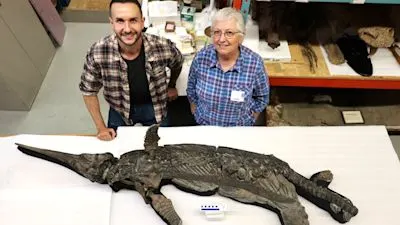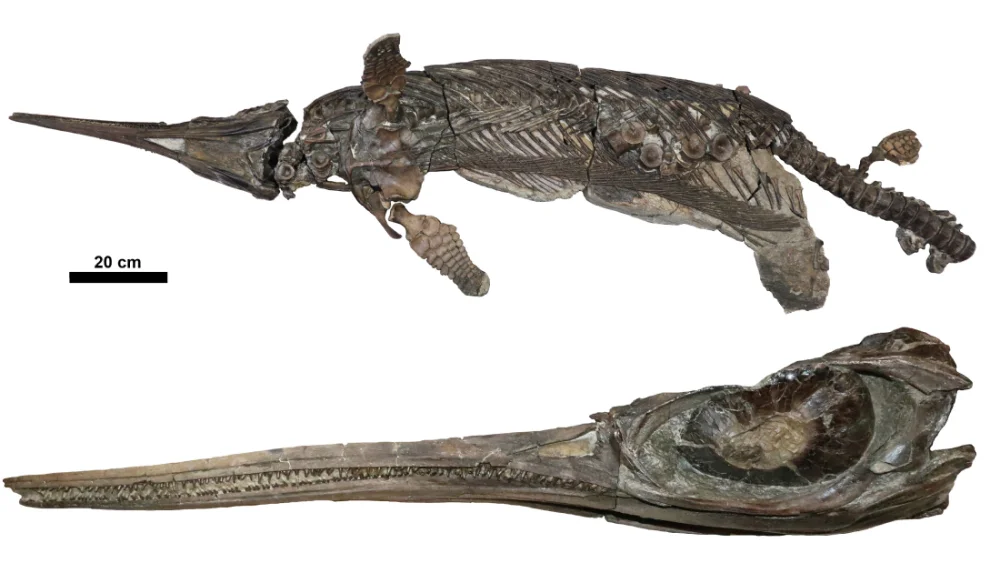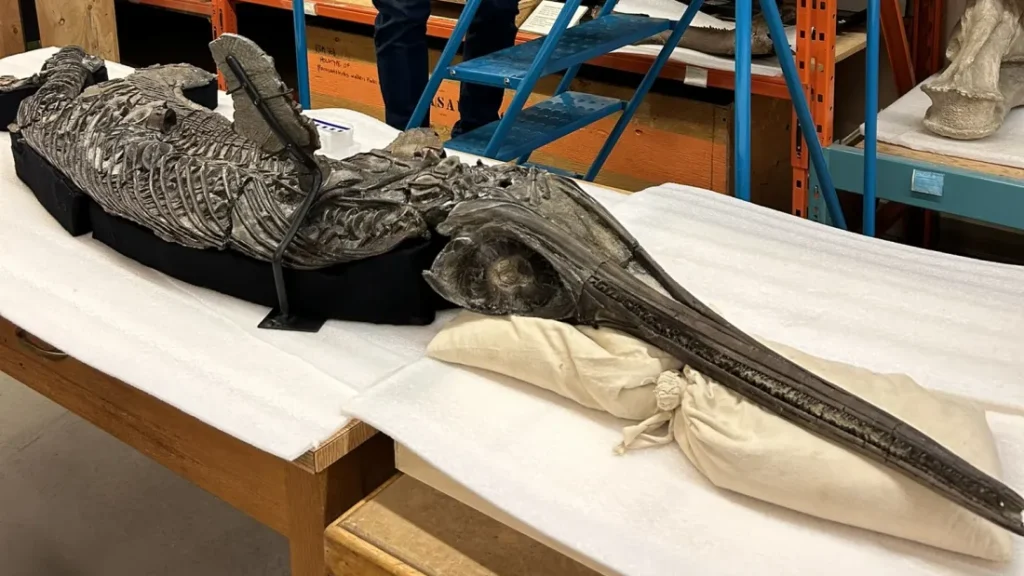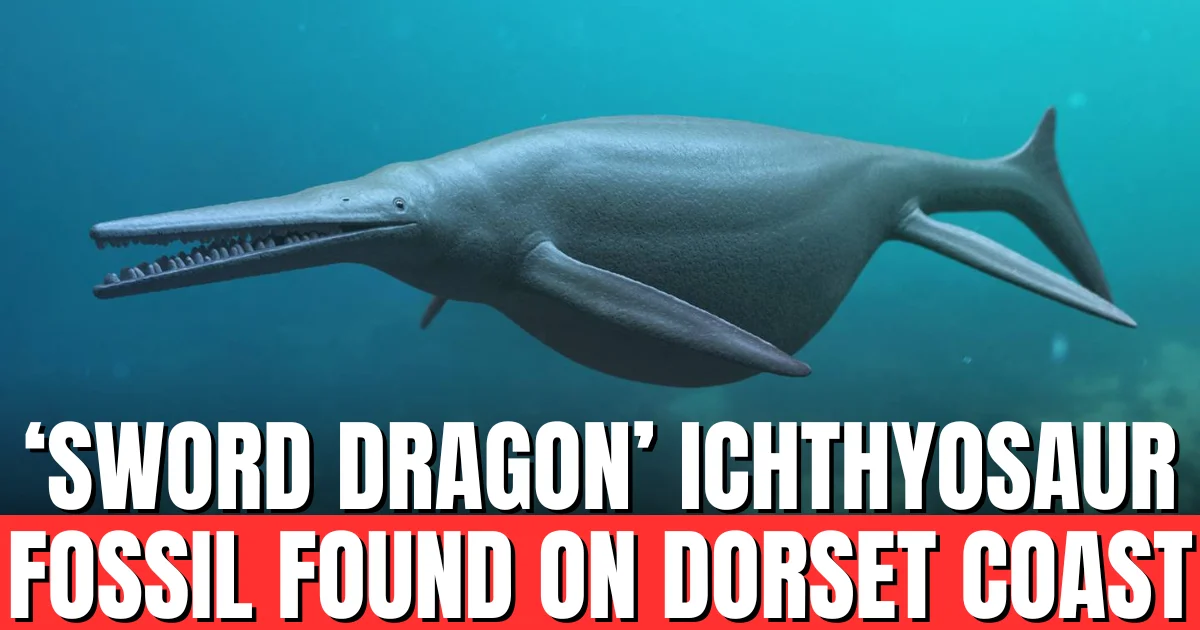Discover Dorset’s ‘sword dragon’ ichthyosaur fossil. Learn its history, unique features, and what makes it a prehistoric marine marvel.
Table of Contents
Fossil Found on Dorset Coast Reveals Unique ‘Sword Dragon’ Ichthyosaur
The Jurassic Coast of Dorset has yielded yet another remarkable discovery: a nearly complete skeleton of a previously unknown ichthyosaur species. Named Xiphodracon goldencapensis, or the “sword dragon of Dorset,” this dolphin-sized marine reptile provides rare insight into life in the oceans 185 million years ago. Its unique features, including a long sword-like snout and massive eye sockets, set it apart from all other ichthyosaur species.

Discovery of the ‘Sword Dragon’
The fossil was first unearthed in 2001 at Golden Cap by prolific fossil hunter Chris Moore. Initially acquired by the Royal Ontario Museum in Canada, it took over 15 years of analysis to identify it as a new species.
Dean Lomax, an ichthyosaur expert and co-author of the study, explained:
“The name Xiphodracon means ‘sword-like dragon,’ inspired by its elongated, sword-shaped snout and the nickname historically given to ichthyosaurs as ‘sea dragons.’”
Physical Features of Xiphodracon goldencapensis

The “sword dragon” measures approximately 3 meters long, with several unique anatomical features:
- Sword-like snout for hunting fish and squid
- Huge eye sockets for enhanced vision underwater
- Prong-like bone near the nostril unseen in other ichthyosaurs
- Malformations in limb bones and teeth, suggesting disease or injury during life
These features make it the most complete ichthyosaur from this era ever found, filling a crucial gap in marine reptile evolution.
Clues to Life and Death
The fossil provides fascinating insights into the life and death of this marine predator:
- Bite marks on the skull indicate it was likely killed by a larger predator ichthyosaur
- Malformed bones suggest it lived with injuries or disease
- Its hunting adaptations reveal it fed primarily on fish and squid
Dr. Erin Maxwell of the State Museum of Natural History Stuttgart noted:
“Surviving in the Mesozoic seas was fraught with danger.”

The Jurassic Coast Legacy
Dorset’s Jurassic Coast has a rich history of ichthyosaur discoveries dating back to Mary Anning in the early 1800s. The “sword dragon” continues this legacy, highlighting the region’s importance in paleontology.
Chris Moore, who discovered the fossil, has unearthed around 15 ichthyosaur fossils, many of which turned out to be new species.
Why This Discovery Matters
Xiphodracon goldencapensis is not just another fossil; it:
- Expands understanding of ichthyosaur evolution
- Highlights predator-prey dynamics in Mesozoic oceans
- Provides new insights into marine reptile anatomy and physiology
- Reinforces Dorset as a paleontological hotspot
This discovery also carries scientific, educational, and tourism significance, as museums and researchers continue to study its unique features.
FAQs About the Sword Dragon of Dorset
Q1: What is Xiphodracon goldencapensis?
A1: This recently recognized ichthyosaur species, found along Dorset’s Jurassic Coast, has been nicknamed the ‘sword dragon.’
Q2: How long did the sword dragon live?
A2: Xiphodracon lived approximately 185 million years ago in the Mesozoic oceans.
Q3: How was it discovered?
A3: Fossil hunter Chris Moore found it in 2001 at Golden Cap, Dorset.
Q4: What makes this ichthyosaur unique?
A4: Its long sword-like snout, huge eye sockets, and prong-like nostril bone distinguish it from other species.
Q5: Where is the fossil now?
A5: The skeleton is housed at the Royal Ontario Museum in Canada for study and display.
Conclusion
The discovery of the Dorset “sword dragon” ichthyosaur is a major milestone in paleontology, shedding light on the oceans’ ancient predators. With its unique anatomy and mysterious death, Xiphodracon goldencapensis captivates scientists and fossil enthusiasts alike.

